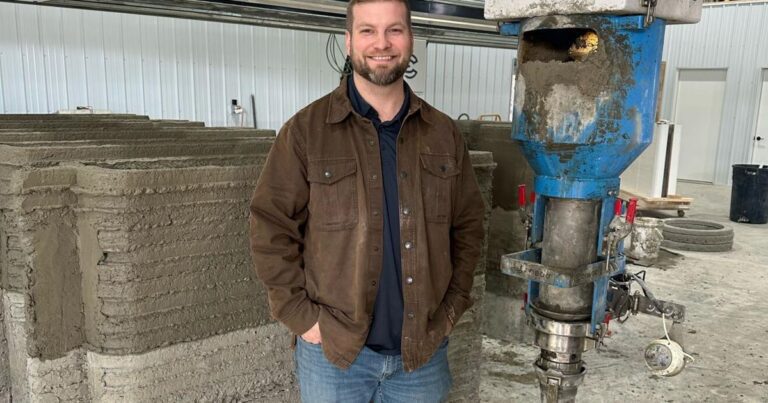MONTICELO — Monticello will soon be home to the largest 3D printed building in the Midwest.
At least that's what Nathan Lilly, its founder, thinks LX 3D concrete printingplans to carry out, and is just getting started.
His company uses a large-scale 3D printing machine equipped with a patented nozzle and customized concrete recipe to print buildings that Lilly said are more resistant to floods, mold, fires and tornadoes than structures made of standard materials.
The buildings are also more energy and cost efficient and take much less time to construct. The printer can place 10 inches of concrete per second, so the walls of a 2,000-square-foot building can be constructed in less than 20 hours.
The method, Lilly said, has the potential to revolutionize housing to become more affordable, durable and less dependent on the supply chain.
“We're actually building a structure that would be prohibitively expensive to compete with if it was actually made of wood,” Lilly said. “Here's an easy way to explain it. There's a book called The Three Little Pigs, right? We're in house number two and we're changing it to house number three.”
Lilly broke ground on its first building, a 1,500-square-foot structure in Monticello, last fall. He said he's now just waiting for permits to be approved before he can start breaking ground on an 8,000-square-foot industrial-office combination building this spring that he plans to lease later.
Born in central Illinois, Lilly said he worked in real estate investment and development — most recently as chief financial officer for student housing company JSM Living in Champaign — before starting LX two and a half years ago.
The idea began, in part, after its parent company, Lilly Capital, a private equity firm, began looking at acquiring a chain of local hardware stores.
But one team member argued that hardware stores would be put out of business, Lilly said, if a store could print whatever part a customer needed right then and there and not have to carry inventory.
Lilly said it then decided to look into printer technology and acquired a $1 million concrete printer from Danish company Cobod. The machine can print walls 25 feet high without moving.
Although the machine works with standard-grade concrete, Lilly said he improved the ratio of its ingredients and developed a special nozzle to allow the machine to print buildings that look like they were built using traditional methods.
A common criticism of concrete construction is that cement requires high heat and a large carbon footprint to bond with local aggregates. Lilly said it has conducted tests with more environmentally sustainable alternatives, but those alternatives have not yet been structurally approved.
“The printer is really just a delivery vehicle,” Lilly said. “So it's very easy for us to adapt and change to any improvements in material design, whether it's fly ash or some alternative that dramatically reduces the carbon footprint of real cement.”
Additionally, manufacturing 3D-printed buildings cleans up less waste because the company makes only the materials needed from a mixer on site, Lilly said. And concrete buildings can last much longer than structures made primarily of wood or plastic.
Lilly's number one goal when she started LX was to create homes, but she added that it would be foolish to limit the company to use alone. This is because printing technology has the potential to create other concrete objects more efficiently, such as concrete pipes for city utilities.
For example, Lily said she had already covered plans to mass-produce a three-year supply of caps for a septic tank company in one day.
“Originally, we were just planning on subcontracting larger residential buildings, but somehow we realized that the only way to add value to the most people possible is to not turn people away,” Lilly said.
“Really, if someone wants a structure built, we'd certainly be open to it. Our goal is to invest heavily in space and protect the entire world if we can—at least the Midwest.”

